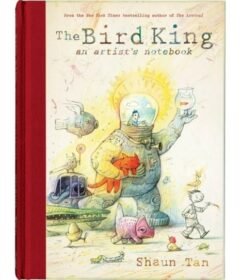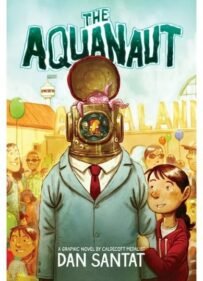Illustrations Sell?
This post contains affiliate links which means we may earn for purchases made through links. Read more.
My inspiration in creating this post came when I saw the first book cover below, when I was familiar with the second book below. If seeing these two books sitting next to each other, you may believe them to be similar stories – although the illustration styles are very different. They seem to be stories of ingenious or alien animals crafting an environmental suit to explore the new world (or at least new to them). This made me think – obviously the illustrations will drive me to pick one up for review before the other (I won’t reveal which); but how much does the illustrations drive the purchase of the book.


My Belief
In my mind and habits, the visuals of the book clearly influences the sale of the books. This is more clearly the case for Graphic Novels than for Young Adult Novels that rely less on the illustrations. And when I asked my 11 year old about this theory, I sensed he agreed. I know for a fact that he won’t take a book home from the library if the illustrations do not resonate with him.
In all fairness, I realize that I and my son have likely missed out on many great well-written books, with stories that could have stuck in our memories or shaped my son’s view of the world. And this must be a challenge to writer’s and publishers who do their work in order to have their books chosen and read. I recently attended a class at a local Writer’s Center on the subject of getting published. I learned during that class, that (for new book authors) the writing gets you an agent; then the agent gets you the publisher; and the publisher gets you the illustrator. So unless you are the complete package of gifted writer and illustrator, it becomes a game of chance on your illustrator matching. The class warned us to check our ego as potential book writers – the author’s vision might not always align with the illustrator’s interpretation; but that is part of the journey in growth. Sometimes, publishers assign a well-known illustrator to a debut author to boost the book’s chances of success.
And I am not stating that great illustrations alone sell books. Take the success of Dog Man and Captain Underpants for example. I don’t think that many will claim the illustrations to be masterful or of a great artist of our time; but they are wonderful at conveying the sense of humor that illustrations can touch in the reader that picks the book up at a store or library. Unlike current news that emphasize the tragic and bad. I believe illustrations that convey the following emotions are the most powerful in driving sales and circulation –
Joy and Humor (obvious layups); Wonder and Amazement; and Hope and Inspiration.
Together, the expressiveness of these visual elements can give illustrators a well-rounded set of tools for stirring emotion and (further) storytelling within books.
Quotes from Dav Pilkey on the Importance of Illustrations
Dav Pilkey, the creator of the “Captain Underpants” and “Dog Man” series, has spoken on many occasions, about the role of illustrations in engaging his target readers, through quotes from his flap covers and an interview with Scolastic [https://www.scholastic.com/parents/books-and-reading/raise-a-reader-blog/13-inspirational-quotes-dav-pilkey.html]
- Creativity and Humor: “Creativity is my superpower,” Pilkey says, emphasizing the imaginative and silly illustrations that draw kids in. He believes that humor can change the way kids take on and deal with life, giving them a special perspective from which to see the world around them.
- How He Sees Illustrations in His Books: Pilkey said, “Once I have the story in my head, I write it down. The illustrations usually come last.” This highlights his concern with the visual side of people while he tells stories, as this increases accessibility and readability for all children.
- On Engaging Reluctant Readers: “My goal with The Adventures of Captain Underpants was to invent a style which was almost identical to that of a picture book – in a novel format,” Pilkey said. He wanted to make books as visually appealing as possible, by cramming every page with more pictures than words, so even non-readers would want them.
These insights from Pilkey emphasize how crucial illustrations are in making books appealing and accessible, especially for reluctant young readers who might otherwise avoid reading.
The Power of Illustrations in Children’s Books
In my experience, and as echoed by many authors and illustrators, illustrations significantly influence the sale of books and their selection in libraries. This is particularly true for graphic novels, where visual appeal is most important.
The moody pictures in Jon Klassen’s “The Skull” are sure get the attention of young readers. The deft lyrical prose and the delicate turning of pages make for a richly rewarding read. Klassen does so well, both in text and illustration because he has this mastery for the economy of it all — which makes his work just quietly terrifying but funny.
Current children’s book illustration trends lean towards diversity and inclusiveness. Yet Fiona Lumbers ‘Ghost Orchid’ is perfect evidence of diverse representation in character and setting that can feel at home with younger readers, as they read to see themselves reflected back.
The Mona Lisa Vanishes takes educational storytelling to a new level through illustrative works over historical events made by Brett Helquist in an engagingly easy-to-understand manner. His work illustrates how graphics can serve and facilitate storytelling, rendering often complex subjects to be more digestible and compelling for a younger readership.
Illustrations are an essential part of making children’s books more attractive and keeping its reader interested, as the given examples show Visual heavy narratives, when combined with storytelling can make all the difference in grasping a young readers attention – showing how powerful an image really is.
Illustrators that Became Writers
Many graphic novel illustrators have done quite well moving into also writing. Some of the more notable examples – and what they brought to the table – include:
Kazu Kibuishi: Creator of the popular “Amulet” series began as an illustrator and later wrote and illustrated his own graphic novels. The pairing of perfect narrative with detail-packed artistic vision, makes the Amulet series a favorite among young readers.
Victoria Ying: A celebrated illustrator, Victoria Ying has also been doing double-duty authoring the graphic novel Hungry Ghost. This beautifully illustrated novel tells a personal and emotional story, looking at questions of identity and self-acceptance. The way Ying has combined powerful visuals and storytelling shows how successful an integrated approach can be in capturing the audience emotion.
Sarah Myer: Sarah Myer has transitioned from illustration to writing with her graphic novel “Monstrous.” Myer’s illustrations creates an immersive experience that brings the characters to life and captivates readers. In “Monstrous”, she writes about the process of self-discovery and how humans must learn to fight not only their external demons, but demons within themselves as well – something that more likely than not will resonate with teens.
Phoebe Wahl: Known for her distinctive and heartfelt illustrations, Phoebe Wahl decided to try her hand at writing with “Phoebes Diary”. Wahl has always excelled in evoking sentiment with her art, and this emotional depth marries well to the tone of narrative she chooses for YA readers. Her work often celebrates the nuances of teenage life, and the journey toward self-actualization.
Jason Reynolds, a best-selling author (and the National Ambassador for Young People’s Literature), has written Ain’t Burned All The Bright along with illustrator Jason Griffin. The collaboration offers a glimpse of how illustrations may be integrated to address big social problems with strong narrative voices for young adult readers, making it an enlightening read.
Kami Garcia: Best known for her work on the “Teen Titans” series, Kami Garcia has proven that she wields a similar sword and pen on the other side of creativity. Tan’s graphic novels like Teen Titans: Raven and the companion, Teen Titans: Beast Boy have managed to give young adult fans some strong visuals as well as rich character work both.
Authors Who Relinquished Illustrations for Better Sales
There are also cases where authors started out as their own illustrator, then later commissioned the illustrations to others for greater success and appeal.
Roald Dahl and Quentin Blake: Roald Dahl started off doing drawings for his own works, eventually he found more success in using the work of illustrator Quentin Blake. The distinctive and imaginative pictures Blake created helped to thrust Dahl’s books into the mainstream, as well as signifying his stories. The collaboration demonstrated the added depth a fine illustrator could bring to a story, enhancing it and leading to increased sales.
Maurice Sendak, illustrator and writer for “Where the Wild Things Are,” Maurice Sendak started by illustrating his own books but also worked with other writers. It was through his collaborations that he realized the potential reach and sales power an illustrator with talent may potentially contribute to a book. The illustrations done by Sendak have become some of the most iconic in children’s literature and helped enormously to catapult the books he illustrated into very successful publications.
In demonstrating that illustrators play a significant role in the success and reception of literary pieces, these were only some examples which help with enriching the story for enthusiast readers.
Do Book Sales Provide any Proof?
According to Publishers Weekly – The middle grade category, which includes graphic novels, saw a quarter of its sales driven by graphic narratives. Authors such as Dav Pilkey and Raina Telgemeier have helped solidify this movement, proving that illustrations can also pique the interest of readers and lead to better sales. And social media platforms like BookTok have driven substantial sales in the YA segment; the visual appeal of books, including covers and illustrations within the chapters, plays a crucial role in their popularity on social media.
Summary
Illustrations or very important for the success of children’s books and graphic novels, particularly for first-time authors. The best-fit illustrator can bring a story to life, raise its emotional impact, and boost its sales. There is also a case to be made, that an accomplished illustrator has a greater chance at success when turning author (and illustrator). Books like Kazu Kibuishi’s “Amulet” series and Raina Telgemeier’s graphic novels have become bestsellers due to their compelling illustrations and equally imaginative stories, illustrating how visual appeal and narrative depth work together to greater impact.
This discussion ties into broader conversations parents often have with children about the importance of looking beyond surface appearances… don’t judge a book by its cover… and beauty is more than skin deep. Just as a book’s illustrations can add depth and beauty to the story within, it’s essential to teach children that true beauty lies beneath the surface. The message of “beauty being skin deep” aligns with the idea that while illustrations can draw readers to a book, the story’s substance and emotional depth ultimately determine its value.
Books Mentioned
We appreciate your use of our marketing links, when considering purchases direct from Amazon. As an Amazon Affiliate, we earn from qualifying purchases.



